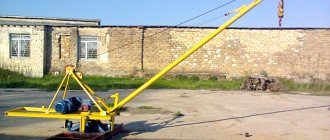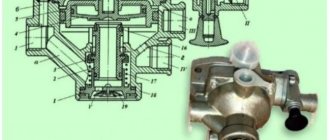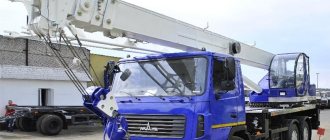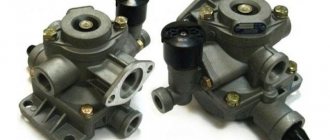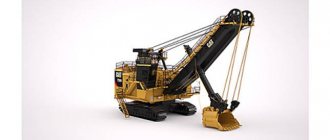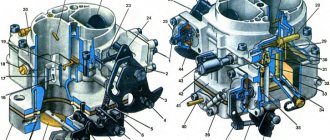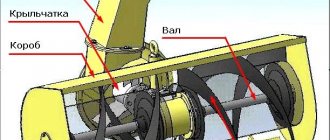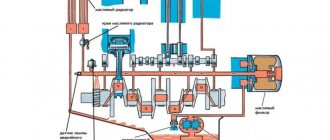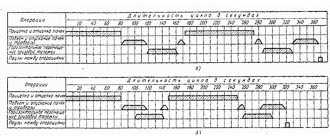Carrying out construction, installation, repair and loading and unloading work at construction sites of buildings and structures, warehouses, bases of trading enterprises and landfills is impossible without the use of specialized lifting equipment.
The Pioneer jib crane is a widely used model for general industrial use. The device easily supplies building and roofing materials, roofing felt, insulation, and tools to the roof, and moves machines and elements of installation structures. The mechanism can be operated both at low temperatures down to -40°C and up to +40°C.
Design and principle of operation
The crane is a collapsible structure, installed at different construction sites with a permissible slope of no more than 3°. The mechanism is manufactured in several modifications in accordance with GOST 1451-77.
The main assemblies of the lift:
- rotating frame with drive;
- running frame;
- arrow;
- hook suspension;
- final stop mechanism;
- screed;
- cargo rope;
- counterweight;
- load;
- safety rope;
- travel switch;
- winch;
- electrical equipment.
The running frame can be stationary or wheeled.
The boom is made in a collapsible design or in one piece. The thickness of the arrow is no more than 10.2-13.3 cm. The length does not exceed 3.5 m.
Rope thickness - 0.69-0.78 cm.
The minimum counterweight weight is 750 kg.
Depending on the load capacity, the crane can be rotated in 2 ways:
- manual;
- mechanical.
The winch is driven by an electric drive with a power of 4-4.75 kW, operating from a network with a voltage of 380 V. The mechanism raises and lowers the load to a height of 4.5-6.2 m with a boom extension of 250 cm at a speed of 8.4-16 .8 m/s. The crane platform rotates around its own axis. In some cases, a special platform cradle is installed.
The control process is carried out by the operator using a remote push-button remote control.
Pioneer lifting mechanisms are divided into 3 types based on maximum load:
- 0.5 t;
- 0.75 t;
- 1 t.
All other characteristics depend on the carrying capacity.
Crane diagram
To make a reliable base with a frame, channels with a rectangular pipe are needed. Additionally, you need to weld the corners to maximize the strength of the base. Rotating frames can also be made from channel bars; you just need to know how to use welding or invite a specialist. To assemble the telescopic unit, you need to mount sliding guides and lubricate them with special products to reduce friction.
Afterwards, a small rectangular platform for ballast is welded. It is convenient to lift a load using an electric motor if you connect its shaft to a winch. To ensure the functioning of the structure, it is necessary to select the minimum permissible cable diameter.
It is recommended to make the chassis on which the boom is mounted from channel material. A shaft made of round metal on bearings is installed into it, then a seat is cut out for the boom. All that remains is to secure the five-meter beam with metal ties, and then place a pulley at the very end of the boom through which to throw the cable.
Pioneer-500
The Pioneer-500 crane is a device for lifting loads up to 500 kg, which is installed both on the roof or ceiling and on the ground. When carrying out work on the roof, the maximum lifting height can reach 50 m, at ground level - up to 4.5 m. To repair flat roofing surfaces, the mechanism is lifted, installed and connected to an electrical network with a voltage of 220 V, 50 Hz via a flexible cable. For low-level work there is the possibility of attaching to the ground zero point.
The load is gradually lifted at a speed of 16.8 m/min, the platform rotates 360° with a rotating boom, moving the material to the desired location. The turning mechanism is manual, while the process is controlled, the lifting mechanism is electric.
The length of the solid boom for Pioneer-500 is 5200 mm, diameter - 102 mm. The dismountable device consists of 2 parts, each 2700 mm long, connected by bolts.
The chassis with a rotating frame has the following transport dimensions:
- length - 2450 mm;
- width - 1770 mm;
- height - 1325 mm.
Dimensional and weight characteristics of the crane:
- length - 4200 mm;
- width - 1700 mm;
- height - 5400 mm;
- weight without counterweight - 395 kg;
- total weight - 830 kg.
The mini crane can be easily dismantled, disassembled, moved manually to another place, assembled and re-installed.
We need a crane to build a private house, but renting one is expensive, so we make it ourselves!
Any user of forumhouse.ru will agree with the statement that one of the most necessary equipment during construction is a crane.
The steel hero becomes an indispensable assistant when the need arises to lift a large load. A lifting mechanism is usually associated with a huge structure tens of meters high. However, in private house-building, when compact mechanisms for construction come to the fore, one needs an option with a boom length not exceeding 5-7 meters. But renting it is not a cheap pleasure, especially if the construction lasts for more than one month.
In this case, there is only one way out - roll up your sleeves and build a homemade mini-crane with your own hands. And our forum members will help you with this!
How to make a homemade faucet
Saving on your own health and trying to manually lift an unbearable load, especially if the construction of a house is carried out independently and without the involvement of hired labor, does not lead to good things. We have already told our readers how to build a vibrating table and vibrating plate on their own. Now we are making a crane with our own hands to build a house called a “mini-pioneer”.
The basis of the mechanism is a supporting running frame, installed permanently or on a mobile chassis. The rotating part of the crane is mounted on the frame. The boom can be rotated manually or electrically. The crane design itself is made on a modular basis and can be disassembled into several parts for the convenience of moving the mechanism from one construction site to another.
The experience of our forum member, who decided to build a mini “Pioneer” on his own, is interesting. He needed this construction mechanism to build a private house made of timber. Voldemort:
“I am almost single-handedly building a house from six-meter timber. It is impossible to lift and carry it alone. That is why I decided to assemble a mechanism in order to take the timber from the stack, place it at the sawing site and lift it to the plinth.
A forum member assembled the frame from a corner 63x63x5 mm. The 5-meter-long boom was made from a pipe with a diameter of 50 mm. To strengthen the structure, two corners of 30x30x3 mm were used. Voldemort’s plans also include further lengthening the boom by another 2 meters.
Voldemort:
– The lifting capacity of the mechanism is approximately 150 kg, but the design can lift more weight, and in order to achieve this, it is necessary to increase the multiplicity of pulleys.
The simplest pulley allows you to get a three-fourfold gain in strength; we should not forget that friction losses are inevitable in this system. Even in the best block models they reach 10%. And the more you gain in strength, the more the distance over which the equipment can move the load decreases.
Voldemort:
– It took me a week to make all the components and mechanisms. I spent another two days assembling and fine-tuning the mechanism. The swing drive and the boom lift drive are a six-fold manual pulley. The lifting drive is also a manual double chain hoist.
Voldemor notes that it would be much more convenient to control a mechanism with electric drives - to lift the load from a remote control on a long cord, as is done in industrial models. But in this case, the complexity of manufacturing all the mechanisms increases significantly, which will lead to an increase in the cost of the design and an increase in the time for manufacturing the crane.
Pioneer-750
The Pioneer-750 crane has technical indicators similar to the 500th model.
Module features:
- the mass of transported cargo is increased to 750 kg;
- lifting speed - 8.4 m/min;
- moving height - 45 m;
- manual rotation - using a special lever;
- load lifting mechanism - AIR100L4EU3 electric motor with a rated power of 4 kW and a rotation speed of 1410 rpm on 3-phase alternating current;
- control is carried out by a 220 V remote control;
- most units are made stationary, the booms are non-removable with a reach of 4.5 m;
- dimensions - 4.2x2.0x5.4 m;
- transport width - 2.18 m;
- transport length - 2.67 m;
- height - 1.35 m;
- weight - 1355 kg.
Portable lightweight cranes
Light weight, the ability to assemble the crane and disassemble it into sections, which can be delivered to hard-to-reach places on a construction site, make the crane a good assistant when lifting building materials.
The cantilever-beam crane (Fig. 5.6.1) is designed for lifting and supplying various building materials into the building through door and window openings.
Rice. 5.6.1 Portable lightweight jib crane
The crane consists of a vertical telescopic tubular stand 5 with support shoes 1 and 6, a beam boom 9 with a load carriage 8, mechanisms for moving the carriage and lifting the load. The telescopic stand allows the crane to be installed in rooms of varying heights.
It is made of two sections: the main (fixed) and retractable. A beam boom is pivotally attached to the main section of the rack, held in working position by rigid rods 7. A load carriage 8 moves along the lower shelves of the boom on support rollers.
The mechanism for moving the carriage consists of a traction rope 4, guide blocks and a manual winch 3. The traction rope, wound onto the winch drum, goes around the guide blocks and is attached to the carriage on opposite sides with two free ends.
By rotating the drive handle, the carriage is moved along the boom.
The maximum lifting capacity of cantilever girder cranes is 0.1-0.2t, the boom reach is up to 3 m, the rope capacity of the drum is 40-70 m. KOR-200 crane (photo 5.6.1).
Photo 5.6.1 Crane KOR - 200 Saratov. Window crane KOR-200 with an electric winch TL-12B, designed for operation in a non-explosive environment. The tap is installed in the window opening. Lifting and lowering construction loads weighing 200 kg. The KOR-200 crane is controlled by a pendant push-button remote control. Does not require counterweights.
Technical characteristics of the KOR-200 crane
| Load capacity, kg | 200 |
| Lifting height, m | 200 |
| Angle of rotation relative to the vertical axis relative to the initial (average) position, degrees. | 100 |
| Lifting speed, m/sec | 0,24 |
| Maximum boom radius, mm | 1260 |
| Control method: | using the control station |
| Crane weight without winch, kg | 45 |
| Power V; frequency Hz | 220 / 380; 50 |
Jib crane
The maximum lifting capacity of cantilever beam cranes of the Pioneer type is 0.5t-1t, boom radius up to 3 m, drum rope capacity 40-70 m. Jib full-rotary portable crane (Fig. 5.6.2)
Rice. 5.6.2 Jib full-rotation portable crane
The crane consists of a base with a skid 1, a rotating platform 3, a tubular boom 9, a load lifting mechanism and a control system. A tubular glass 10 is installed in the center of the base, into which the pivot of the turntable is inserted. A cargo winch 5 and a counterweight 2 are located on the turntable console.
A tubular boom is hinged to the rotating platform at the front and is held in working position by guys 4. The boom reach is changed by changing the length of the guys. The load lifting mechanism consists of a reversible worm winch 5 with control devices, a cargo rope 6 and a hook holder 8.
Rotation of the platform and movement of the crane are done manually. Photo 5.6.2 of the Pioneer crane.
Photo 5.6.2 Jib-beam crane KP-1000 “Pioneer”
Technical characteristics of the Pioneer crane
| Load capacity, kg | 500 | 750 | 1000 |
| when installed on the ground, m | 4,5 | 4,5 | 6 |
| when installed on the ceiling, m | up to 50 | up to 50 | |
| Lifting speed, m/s | 0.2 to 50(100) | 0,14 | 0,74 |
| Drive power, kW | 4,0 | 4,0 | 4.25 |
| Overall dimensions, m | 4.2 x 1.78 x 5.4 | 4.28 x1.7x5.4 | 4.5 x 2.0 x 6.0 |
| Weight without c/g, kg | 480 | 480 | 900 |
| Total weight, kg | 910 | 921 | 1790 |
| Rope diameter, mm | 6,9 | 6,9 | 12 |
Pioneer-1000
The Pioneer-1000 jib crane is an advanced multifunctional equipment with a lifting capacity of 1000 kg. The turning and lifting mechanisms are powered by a 380 V electrical network and a driving power of 4.75 kW, making operation quick and easy.
The arrow is produced in 3 versions:
- with a reach of 2.5 m;
- 3m;
- 4 m.
As the length increases, the load capacity and lifting height decrease:
- the boom, designed for a reach of 2 m, moves loads weighing up to 1 ton to a height of 6.2 m;
- at 3 m - up to 0.8 t at a height of 6 m;
- at 4 m - up to 500 kg at 5.3 m;
- for ground mounting - 6 m.
Fixation is done using ties.
Console units are available in 2 versions:
- adjustable;
- mobile on wheels.
On the rotating platform of a stationary lift, special stops are installed that regulate the angle of inclination and protect against tilting.
In a mobile crane, manufacturers construct rails from channels along which movement occurs.
The working speed reaches 11.8 m/min.
In comparison with the Pioneer-500, in which counterweights are hung, in the tonnage counterweights in the amount of 15 pieces of 48 kg each are located in a specially equipped box.
Technical characteristics of KP-1000:
- overall dimensions when assembled - 6100x2140x6500 mm;
- weight without counterweights - 1070 kg;
- total weight - 1820 kg;
- chassis with a rotating frame - 2850x2130x1600 mm;
- boom - 6.45 m.
installation, installation at a construction site, lifting construction, industrial, support
On construction sites, mechanisms of different heights and load capacities are used. The technology makes it possible to erect buildings in a short time; before starting work, specialists assemble the tower crane.
Preparation
Tower cranes are brought to the construction site in disassembled form, then workers assemble them on site. The structures are heavy, so the site must be prepared before installation.
Important How to diagnose KamAZ-6520 Euro-4 “diseases” and what error codes exist
The mechanism consists of the following parts:
- Tower.
- Cabin designed for the driver.
- Console. It is necessary for counterbalance.
- Arrow. Load-lifting mechanism.
First, the place where the unit will stand is leveled. To make the structure more stable, the surface is filled with concrete. Grounding is required and electricity is supplied to the site.
You can install a construction crane using a truck crane, but it must be delivered to the site. Convenient access routes to the construction site should be determined in advance.
How to install taps
Installation of cranes is a fairly simple matter that does not require much time and effort. First, workers build a pedestal; it is necessary to install the mechanism. A tower structure is installed on it and secured securely.
An auxiliary crane is used to move the slewing support mechanism into place and fix it in place. After this, workers move on to building up the remaining parts of the structure. This is a tower, a rotating platform, a device for raising and lowering a load, a mechanism for changing the boom reach.
The individual sections of the lift are moved and assembled using the mechanism's own boom. This allows you to quickly increase the height of the device.
The work uses a mounting device, which is a single frame structure. It differs in that it has a removable front part. The mounting device is necessary both for assembly and further operation of the mechanism.
The assembly of the tower crane is carried out using the control panel of the mounting structure, and an auxiliary remote control panel is also used in the work. Along with assembling the device, workers can install support cranes.
Industrial lifting devices at a construction site can reduce the time required to complete work. The house under construction will be completed in just a few weeks.
Checking correct installation
Regular checks and preventive maintenance are the key to trouble-free operation of the mechanism. Wear and deterioration can be observed on mechanisms that have been in use for many years. Under extreme loads, such equipment fails.
An extraordinary technical inspection is necessary after installing the lifting device at a new workplace. During the technical inspection, the operation of mechanical and electrical equipment, safety devices, brake systems and control units, as well as alarms is checked.
During a full inspection, the following will be checked:
- What condition is the metal structure in? The condition of its welded joints is taken into account. Experts look for tears, deformations, rust and other damage. They check the condition of the cabins, stairs, platforms and guardrails.
- The technical condition of the hook and suspension parts, taking into account the degree of their wear.
- How the cargo ropes are secured, their condition.
- Appearance of blocks and fastening elements. Suspension components must be checked.
- Grounding of an electric tap powered from an external network.
- The relationship between the counterweight mass and the ballasts of a tower crane. The obtained values are compared with the numbers indicated in the passport.
When installing cranes and carrying out inspections, they are guided by the information specified in the instructions. The document is drawn up by the manufacturer of the tower mechanism.
specmahina.ru
Pioneer-2000
The Pioneer-2000 crane is an improved version of the KP-1000 lift. After upgrading the model, the liftable load can reach 2 tons. This module is manufactured by the manufacturer to special order and is in demand in the construction of facade structures, when installing windows and sandwich panels.
Features of the 2-ton truck:
- equipped with electromagnetic hydraulic brake;
- electric drive for boom rotation;
- gearbox, power unit and winch with a 4-fold safety margin.
Taking into account the console reach, the maximum lifting capacity with double reeving of the rope is:
- with a reach of 4.6 m - 1500 kg;
- 4.4 m - 1700 kg;
- 4.1 m - 2000 kg.
Maximum lifting height of the hook mechanism:
- at reach 4.6 m - 4.3 m;
- 4.3 m - 4.5 m;
- 4.1 m - 4.65 m.
The maximum depth of lowering the hook is 100 m with a double safety margin of the rope.
Unit operating speed:
- with single reeving - 5.6 m/min;
- at double speed - 11.3 m/min.
The rotating part moves 360° around the axis. The turning radius reaches 3 m.
Structural weight - 1.5 tons.
Homemade mini crane based on a bottle jack
To make a hydraulic crane, we will use available materials that many people have in their garage.
We recommend: Do-it-yourself straightening hammer made from leftover copper and bronze
And even if you don’t find anything suitable at hand, everything you need can be purchased for pennies at a ferrous metal shop.
The lifting mechanism is useful both in the garage (for example, to raise and lower a car engine), and during construction work - for installing and dismantling various metal structures.
Basic materials that will be required to make a mini crane:
- profile pipe with a wall thickness of at least 3 mm;
- metal plate 5 mm thick;
- bottle jack (load capacity is at your discretion);
- swivel wheels;
- steel chain with hook.
Main stages of work
The first step is to make a support for the hydraulic mini crane. For this we need profile pipes.
Using a grinder, we cut pieces of suitable length and weld the base. After this, it will be necessary to weld a vertical stand to the support.
We weld two metal plates to its upper part, to which the lift boom is attached.
As a drive that will raise and lower the boom, we use a hydraulic jack with a lifting capacity of 12 tons (you can use another jack).
We weld a piece of profile pipe to the vertical post at an angle, which will serve as a stop for the jack.
We cut out a square plate from sheet metal and weld “ears” to it. Using a bolt and nuts, we attach the plate to the stop - this is a movable platform on which the sole of the jack will rest.
We weld a “glass” to the bottom of the boom for the support point of the jack piston. Next, we clean the welds with a grinder, after which we paint all the manufactured elements.
Assembling a load-lifting crane
We attach the bottle jack to the movable support platform on the vertical stand. We lower the boom so that the jack piston enters the “glass”.
We recommend: A simple hydraulic press using a jack
We install the retractable section of the telescopic boom, to the end of which we attach a chain with a crane hook.
This homemade lift is perfect for removing and then installing the engine from the car. It can also be used for other purposes - in the workshop and garage. The design is reliable and inexpensive.
For a step-by-step description of how to make a mini crane from a jack for a garage or workshop, watch the video.
Advantages and disadvantages
The crane is characterized by high mobility, productivity and lifting capacity.
Its main qualities:
- fast transportation to the place of operation;
- accessible assembly;
- Possibility of installation anywhere - on the roof, ground, floors of objects under construction and in pits.
Before the process, pits are not made and anchors are not used.
The Pioneer lift has low energy consumption, low cost, and is not registered with Rostechnadzor. Persons without special qualifications are allowed to operate. Maintenance costs are minimal.
The disadvantages of modules are:
- the load that is suspended from the crane does not always create safe working conditions;
- The maximum weight that the crane can lift ranges from 500 to 1000 kg, depending on the design.
Technical specifications
Cranes of the Pioneer models are mobile rotary units equipped with an electric drive. They are actively used on most construction sites. The undoubted advantages of such special equipment are the following indicators:
- ease of moving equipment and its assembly;
- minimum power consumption (no more than 1.5 kW);
- the angle of rotation of the boom mechanism is unlimited;
- load capacity varies depending on the modification of the unit;
- reliability of design;
- the presence of safety systems to ensure trouble-free operation of equipment.
It is recommended to install this lift on the floors or roof of a building that is being built or renovated to ensure lifting to the desired location and moving the required equipment and necessary materials there. Such special equipment is useful for owners of shopping complexes. It ensures fast actions when performing loading and unloading functions regarding large goods.
The passport technical parameters of the most common modifications of the crane are summarized in the table:
DIY crane
Section: Useful devices
Modern houses are being built higher and higher, but concrete blocks are not getting any lighter. Therefore, if you think carefully, you can build a small crane with your own hands. The carrying capacity of such a homemade product is not great, about two hundred kilograms, although, most likely, it can lift more weight, but it is not advisable to overload it. This design turns out to be completely collapsible, its components weigh approximately 20-30 kilograms, so assembling such a crane alone will not pose any special problems. In addition, such a structure is also easy to transport; the body of a Chinese pickup truck was quite suitable for this.
Let us remind you that we have previously published an article about a homemade tiny crane, if you are interested, take a look here.
The cargo winch of my design is a worm gearbox with a 600 W electric drive, while the jib winch is a manual drive, organized on the same gearbox. Outriggers with screw stops are borrowed from construction supports. Drums for the winches were machined from rotors from electric motors, and suitable sizes were selected.
On the base of the mobile platform there are four wheels taken from the conveyor trolley, thanks to which the crane can be moved from one place to another without any problems, only if the outriggers of the crane are removed. This operation of removing and installing outriggers takes about five minutes. Therefore, the crane turns out to be quite mobile. But there is a small drawback: to move the crane, you need to lower the boom to zero, otherwise it becomes impossible to move the crane, since its balance is disturbed.
The boom itself has a length of 5 meters, the pipe was selected to be about 75 mm, and at the base of the boom itself there is a square profile made from two corners. There is also a portal for raising the boom, as well as a turning unit made from a hub from a truck. As a counterweight, a frame from a non-functioning machine was taken along with four tracks from a caterpillar mechanism. In this case, the brake in the winch is not provided, because it is not necessary. There is also no brake in the turn itself, due to the fact that the speeds are very low, and, therefore, there is practically no inertia.
The minimum thickness of the metal used in my crane is about 3 mm; a rectangular pipe with dimensions of 85 * 50 and 85 * 55 is used as an outrigger and base as a whole - this is a kind of remains of agricultural equipment. The base of the tower is made of channel 200. A powerful bearing is inserted into the hook cage, therefore, the hook is able to rotate regardless of the pulley, to avoid overlap or twisting of the cable itself.
The stop screws are 400mm long, allowing the crane to be installed on very uneven surfaces.
There is one small drawback related to the wheels. The thing is that the wheels used in this case, when moving on loose soil, simply bury themselves in it; on a hard compacted surface - everything is fine. This crane is considered disposable, that is, after completing the necessary work, it is disassembled for scrap or into a shelter until the next use. That is why this design has a low load capacity and not very outstanding strength.
The manufacturing time for such a crane will take about three days, taking into account the preparation of all the necessary components. In this case, the gearboxes were made from what came to hand; the gearboxes have the following gear ratios: 1/30 and 1/35. A three-phase motor was connected to a single-phase network. output parameters on the shaft are 600 W, capacitor capacity is 80 microfarads. All installations without counterweights weigh up to 250 kg, the cost of such a design is 4,000 rubles. Mostly the components used are borrowed from other equipment; only the cables and bearings are new.
Such a crane can easily lift one and a half hundred kilograms of cargo; we have not yet been able to move more at home.
